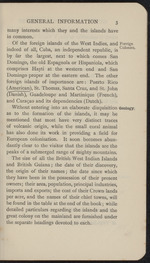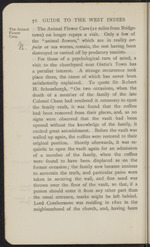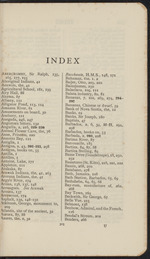| 1 |
 |
“...old Espagnola or Hispaniola, which
comprises Hayti at the western end and San
Domingo proper at the eastern end. The other
foreign islands of importance are: Puerto Rico
(American), St. Thomas, Santa Cruz, and St. John
(Danish), Guadeloupe and Martinique (French),
and Curasao and its dependencies (Dutch).
Without entering into an elaborate disquisition Geology,
as to the formation of the islands, it may be
mentioned that most have very distinct traces
of volcanic origin, while the small coral animal
has also done its work in providing a field for
European colonisation. It soon becomes abun-
dantly clear to the visitor that the islands are the
peaks of a submerged range of mighty mountains.
The size of all the British West Indian Islands
and British Guiana; the date of their discovery,
the origin of their names; the date since which
they have been in the possession of their present
owners; their area, population, principal industries,
imports and exports; the cost of their Crown lands
per...”
|
|
| 2 |
 |
“...The Animal
Flower
Cave.
ft:
76 GUIDE TO THE WEST INDIES
The Animal Flower Cave (21 miles from Bridge-
town) no longer repays a visit. Only a few of
the “animal flowers,” which are in reality ser-
pulcB or sea worms, remain, the rest having been
destroyed or carried off by predatory tourists.
For those of a psychological turn of mind, a
visit to the churchyard near Oistin’s Town has
a peculiar interest. A strange occurrence took
place there, the cause of which has never been
satisfactorily explained. To quote Sir Robert
H. Schomburgk, “On two occasions, when the
death of a member of the family of the late
Colonel Chase had rendered it necessary to open
the family vault, it was found that the coffins
had been removed from their places, and, as no
signs were observed that the vault had been
opened without the knowledge of the family, it
excited great astonishment. Before the vault was
walled up again, the coffins were restored to their
original position. Shortly afterwards, it was re-
quisite...”
|
|
| 3 |
 |
“...BRITISH GUIANA
99
and shallow lakelets of pure water, and in some
places there were little marshes filled with low
scanty and bristling vegetation. And here and
there, alike on level space and jutting from some
crevice in the rock, were small shrubs in form like
miniature trees, but all apparently of one species.
Not a tree was there; no animal life was visible; or,
it even seemed, so intensely quiet and undisturbed
did the place look, ever had been there. Look
where one would, on every side, it was the same,
and climb what high rock one liked, in every
direction, as far as one’s eye could see was this
same wildly extraordinary scenery.”
During the early part of November 1894,
Messrs. J. J. Quelch, F. V. M‘Connell, and C. A.
Lloyd made the ascent of the summit by the same
ledge on the south-west face of the mountain, by
which Sir E. im Thurn ascended, and spent three
days and two nights on the top of the plateau,
which they again visited in 1898....”
|
|
| 4 |
 |
“...a more ex- Mafoiie.
tended view, he should choose the hill to the
west end of the town, known as Frenchman’s
Hill, continuing afoot as far as Solberg. An Solberg.
hour’s walk in the first instance, and a somewhat
longer one in the second, will give him as fine
a view as can be seen in the West Indies, or,
for that matter, in any part of the world. Either
of these trips can be made on horseback, but
as the hills are very steep, and the roads some-
times rugged, it is well to make sure that the
animal to be ridden is sure-footed. If the visitor
be a cyclist, with only a short time at his disposal,
he will find good roads to the east of the town as
far as a sugar estate, whence he can return by a
circuitous route, and, passing through to the west,
proceed as far as Nisky; he thus obtains a view of Nisky.
the suburbs and main street, but will miss the
beautiful views which can be obtained from the
hills. In the neighbourhood of the town, a few...”
|
|
| 5 |
 |
“...INDEX
Abercromby, Sir Ralph, 135,
\ i6S. 177.193
Aboriginal Indians, 41
Acawois, the, 41
Agricultural School, 181, 100
Airy Hall, 88
Akyma, 87
Albany, in
Alligator Pond, 113, 114
Amazon River, 81
Amusements on board, 30
Anchovy, in
Anegada, 246, 247
Angostura bitters, 132
Anguilla, 2, 216, 229-230
Animal Flower Cave, the, 76
Anne, Princess, 220
Annotto Bay, in
Antiglia, 1
Antigua, 2, 43, 202-215, 298
Antigua, books on, 55
Antilla, 1
Antilles, 1
Antoine, Lake, 171
Appleton, in
Arakaka, 87
Arawak Indians, the, 41, 263
Arecuna Indians, the, 41
Argyle River, 174
Arima, 136, 137, 148
Arouagues. See Arawak
Arouca, 137
Arrowroot, 174
Asphalt, 132, 148-150
Atkinson, George, monument to,
* 209
Atlantis, site of the ancient, 32
Aurora, 87, 88
Azores, the, 2, 32
Bacchante, H.M.S., 148, 171
Bahamas, the, 1, 2
Baijer, Otto, 209, 210
Bainsjaunes, 250
Balaclava, 109, in
Balata industry, 80, 81
Bananas, 7, 102, 269, 274, 294-
297
Bananas, Chinese or dwarf, 59
Bank of Nova Scotia, the, 12
Banks, 12
Banks...”
|
|
